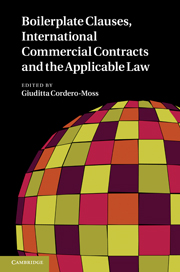Book contents
- Frontmatter
- Contents
- List of contributors
- Preface
- Introduction
- PART 1 How contracts are written in practice
- PART 2 Methodological challenges
- Introduction to Part 2
- 3 Does the use of common law contract models give rise to a tacit choice of law or to a harmonised, transnational interpretation?
- 4 Common law-based contracts under German law
- 5 Comparing exculpatory clauses under Anglo-American law: testing total legal convergence
- 6 Circulation of common law contract models in Europe: the impact of the European Union system
- PART 3 The applicable law's effects on boilerplate clauses
- Conclusion: the self-sufficient contract, uniformly interpreted on the basis of its own terms: an illusion, but not fully useless
- Bibliography
- Index
6 - Circulation of common law contract models in Europe: the impact of the European Union system
from PART 2 - Methodological challenges
Published online by Cambridge University Press: 11 April 2011
- Frontmatter
- Contents
- List of contributors
- Preface
- Introduction
- PART 1 How contracts are written in practice
- PART 2 Methodological challenges
- Introduction to Part 2
- 3 Does the use of common law contract models give rise to a tacit choice of law or to a harmonised, transnational interpretation?
- 4 Common law-based contracts under German law
- 5 Comparing exculpatory clauses under Anglo-American law: testing total legal convergence
- 6 Circulation of common law contract models in Europe: the impact of the European Union system
- PART 3 The applicable law's effects on boilerplate clauses
- Conclusion: the self-sufficient contract, uniformly interpreted on the basis of its own terms: an illusion, but not fully useless
- Bibliography
- Index
Summary
The European Union system and circulation of common law contract models
There are several ways to assess the reception by a legal system of contract models from another legal system.
The easiest way is to examine how a national judge applies his or her law to a foreign contract model. For instance, within the area of contract law could be considered the case law of the Cour de Cassation or the appellate courts and tribunals, in terms of their ability to enforce contract models from different systems of common law.
While not strictly speaking a specialist in contract law but rather in EU and comparative law, I will suggest another line of enquiry. My aim will be to try to show that EU law and, particularly, the case law of the European Court of Justice compel national lawyers to welcome into their systems legal situations located in another Member State. Thus, European law promotes the movement of models and leads the national lawyer to handle rules of foreign systems.
An almost perfect example: the Courage case
In an attempt to illustrate my demonstration, I will rely on an almost ‘perfect’ example: the Courage ruling: ECJ, 20 September 2001, Case C-453/99.
The referral requesting a preliminary ruling originates from a dispute in England involving a brewery and a publican, who were both bound by a lease agreement and an exclusive purchasing clause. The disagreement concerned the settlement of various bills corresponding to deliveries of beer.
- Type
- Chapter
- Information
- Publisher: Cambridge University PressPrint publication year: 2011

